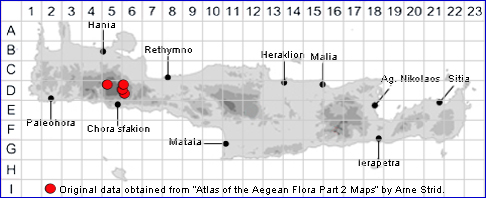
SPECIES DESCRIPTION
DRABA NUDA
Family and Genus:- See- CRUCIFERAE
Common Names:-
Homotypic Synonyms:-
Meaning:- Draba (Gr) Acrid, a name used by the Greek physician and botanist
Dioscorides.
Nuda (L) Bare, naked, thornless.
General description:- Tiny, scapose annual with short, mostly 2-4-fid hairs.
Stems:-
1) Single or few, 1-2 cm, pubescent.
Leaves:-
1) Up to 5.5 x 2 mm, spathulate to oblong-spathulate.entire, with branched hairs
especially on the margins.
Flowers:-
1) Petals, c. 2 mm, retuse, pale yellow.
2) Pedicels, very short, somewhat thickened in fruit.
3) Sepals, c. 1·5 mm.
4) Style, short.
Fruit:-
1) Siliculae, compressed, up to 8 x 0.8 mm, pubescent, with 2- or 3-fid hairs.
2) Seeds, 15-20, in 1 row in each loculus.
Key features:-
1) Stem, very short (up to 2 cm), leafless.
Habitat:- Rocky limestone slopes and flats,1600-2000 m.
Distribution:- The Cretan localities, the only ones in Europe, are widely disjunct
from the main range of the species in SW Asia.
Drabopsis has recently been merged with Draba. D. nuda is a widespread Irano-
Turanian species with a disjunct locality in Lefka Ori, where it was discovered by
Gustavsson (1977) and has been confirmed by later gatherings.1)
Flowering time:- May to early June
Photos by:- Ori Fragman_Sapir & A. N. Other
1) Atlas of the Aegean Flora Book 1 Page 160.



